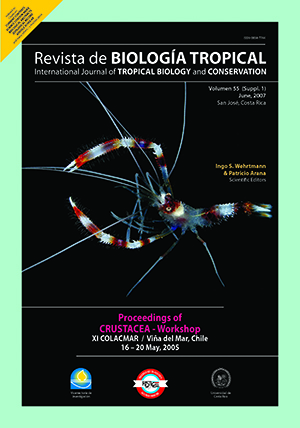Abstract
The amphipod Talorchestia margaritae Stephesen, 1948, is a semi-terrestrial species that inhabits decaying organic material along estuarine shores of the Tuy river, Miranda state, Venezuela. We studied the embryonic development of T. margaritae and used biochemical quantitative methods to determine the protein content of embryos in stages of intra-marsupial development, as well as the consumption pattern of these proteins by the embryos. The smallest reproductive females measured 4.6 mm in body length. A low correlation (R2 = 0.2157; p<0.01) was found between female size and number of eggs in the marsupium. The number of eggs and embryos in the marsupium varied between 3 and 12 egg or embryos/female for all female sizes, regardless of stage. Five developmental stages were observed: the uncleaved egg, three embryonic stages and the juvenile stage. Mean embryo size increased significantly during embryo development: from 536.4±28.4 μm at stage I up to 798.1±18.44 μm at the juvenile stage (stage V). The protein content decreased from an initial mean value of 4.14±0.78 μg proteins/egg to a final value of 2.02±0.46 μg protein/juvenile. Most of this decrease occurred between stages I and IV, a pattern which could reflect an initial higher consumption of the proteins as a source of energy and tissue formation. At the final stages (between IV and V), there were no significant differences between the protein content of the embryos.
##plugins.facebook.comentarios##

This work is licensed under a Creative Commons Attribution 4.0 International License.
Copyright (c) 2007 Revista de Biología Tropical






